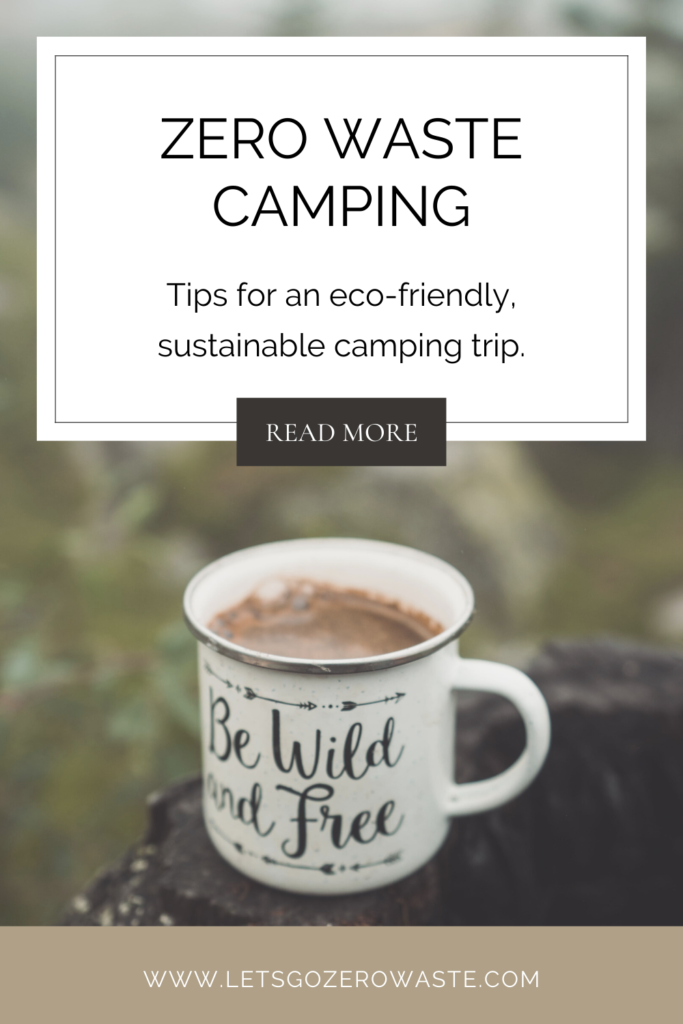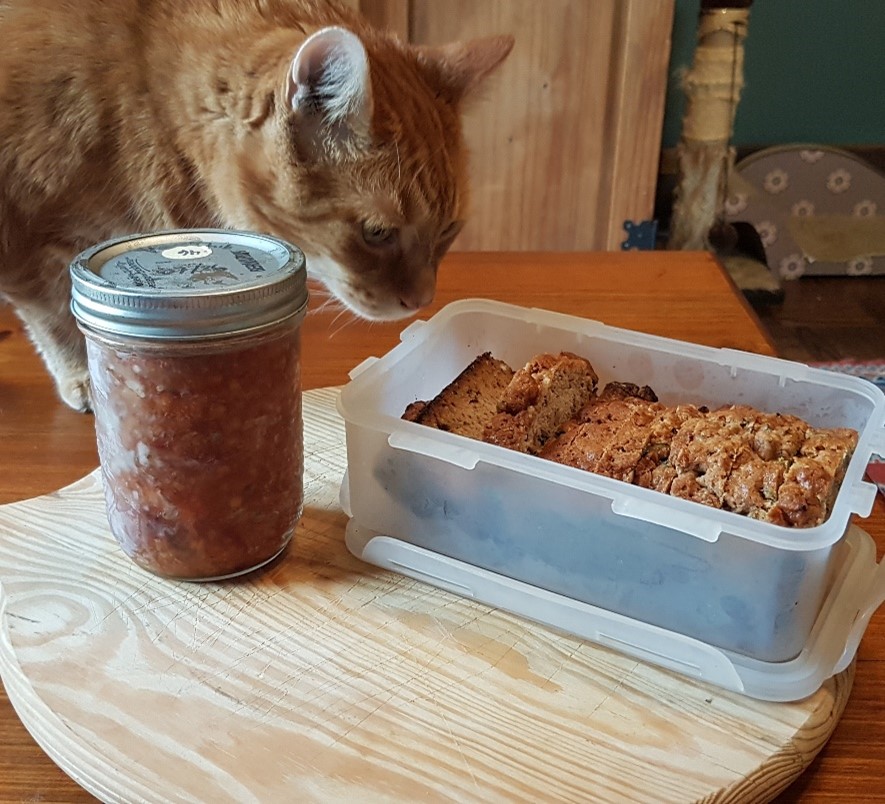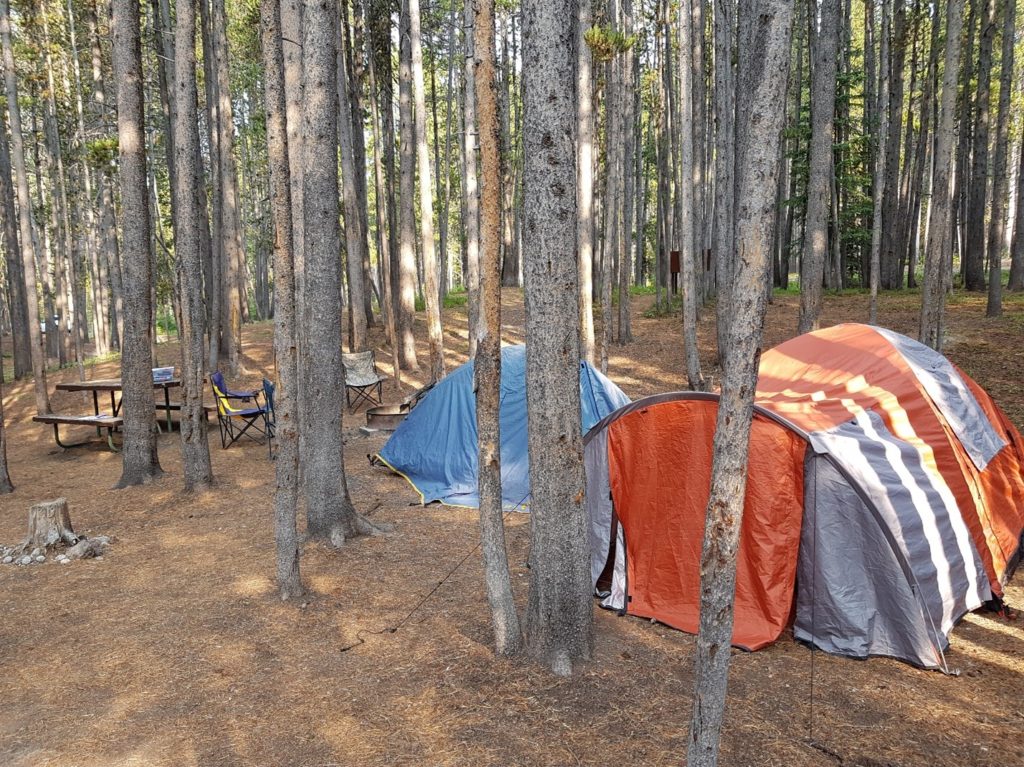This summer I tried zero waste camping for the first time, while also interior camping. Though it definitely wasn’t my first time camping nor was it my first time interior camping, I still learned a lot and I hope to share some tips I discovered through the process.

Now, to be upfront, the interior camping trip I went on was most likely not how you are picturing it. For my first ever interior camping trip we took canoes and portaged a bunch, which is how I picture interior camping. For this zero waste camping trip in the interior of Algonquin Park, we took a motor boat. Yes, a motor boat.
The reason that I’m explaining the difference here is that the tips I will be giving work for campground camping and they work for interior camping with a boat, but they may not work as well for interior camping with canoes or interior camping via hiking. Though I really hope to try out a zero waste camping and canoeing trip soon (fingers crossed).
Zero Waste Camping Tips
Most of the tips here my family has used for “regular” camping forever. However, we just realized while planning for our trip that they are the perfect tips for zero waste camping too!
So, the majority of these tips create almost no extra work because we did this prior to going zero waste and so some are just normal camping tips. Which is fantastic!
#1. Leave no trace & properly dispose of your waste.
The “leave no trace”, “take out what you bring in”, and “properly dispose of your waste” tips are fairly standard knowledge.
However, I never realized in the past that when campground camping we tend to dispose of more into the garbage than we probably would have done at home.
For example, my family has a backyard compost bin and so we have always composted what can go in that bin, such as fruit and vegetable scraps, as well as egg shells. And now, since the summer of 2020 our county has finally started a green bin program and so we can compost all of our food scraps as well as butcher paper in our green bins.
But, pre-zero waste when we were at a campground we would throw our fruit, veggie and other food scraps into the garbage because the campgrounds never had compost bins.
a) bring a compost bin
So, one of our tips is to bring a compost bin with you when you go camping. It doesn’t need to be an actual compost bin, but it should be a container that you can close up tight and that will fit all of your food scraps and any other scraps that you normally compost at home.

b) bring your recyclables home
Another tip is that if there’s no option for recycling at your campground, bring your recyclables home. I think 99% of the campgrounds I’ve been to have had an option for recycling but we thought it should be said just in case they don’t.
And remember, if you are interior camping, bring out what you take in. MEC (Mountain Equipment Co-op) has a great article outlining the 7 Leave No Trace principles that are pertinent no matter the type of camping you’re doing but are very, very important to know if you’re interior camping.
#2. Make your own zero waste ice for your cooler.
Ice for your cooler is something that is easy to forget about until you are ready to pack your cooler. And prior to living low waste it would be a simple enough fix to stop at the closest gas station and grab a bag of ice. But now there’s that pesky plastic bag to take into consideration.
When purchasing ice for your cooler I have heard that there are some locations where you can get the ice “loose” out of a machine like the ones found in hotels. However, I have never actually seen an ice machine like that outside of hotels. The only ice I have seen available to purchase for coolers come in plastic bags.
So, our next set of tips are ways to make your own ice for your cooler and the best part is that you’ll save money too! These are things that we did prior to going zero waste in order to save money and we tend to make our ice more than one way at the same time. For example, for our fall camping trip we did options A & B below.
a) fill empty containers (apple juice jugs, yoghurt containers, etc.) with water and freeze at home into ice blocks.
We have a set of plastic apple juice jugs from before going zero waste that we use as our ice blocks. However, you can use any type of container that fits in your cooler well and that freezes well too. If weight is not an issue, you could probably use glass jars if you’d like.
I know what you’re thinking though: you shouldn’t freeze water in plastic like that (or something along those lines) because of what will be transferred into the water from the plastic.
First and foremost, we most definitely agree that you should NOT drink the water that you have frozen in the plastic jugs.
And, well, I’m not an expert at all and so this may just be me assuming, but as long as you keep reusing the same water and don’t dump it out, then the “contaminated” water shouldn’t have a negative affect on anything because it’s always in the jug… it would probably be pretty similar to what happens with a regular lunch box ice pack if you do it this way.
b) freeze your food (e.g. chili) ahead of time to use as ice blocks.

If you are bringing food like homemade chili, soups or sauces and they’re in glass jars or containers, then a perfect option is to freeze them before you leave and use them as ice blocks!
We also froze a loaf of homemade zucchini bread. This wasn’t so much an “ice block” as it was a “cold” block, but it fit in our cooler and was another item to help keep the temperature down.
c) fill a bag with ice cubes that you make at home.
A third option which may take some forethought and it’s something we always forget about, is to make a collection of ice cubes at home using your own ice cube trays. If you have some plastic bags you need to reuse (like bread bags) this is the perfect time to reuse them!
However it’s important to note that the bigger the blocks (or cubes) of ice, the slower they are likely to melt. So, for us, option A makes more sense than option C. But if you want to put some ice in your drinks then this way may be your best choice.
d) when your homemade zero waste ice melts.
Making your own ice at home prior to your camping trip is such an awesome idea, but we have been on camping trips and camping road trips where we were gone too long or it was too hot out, and all of our homemade ice melted.
So, making homemade ice isn’t always practical. If you end up in that situation, some options to look into could include:
- filling up at a motel/hotel with their ice machines if you stay at one for a night or two.
- just purchasing the ice in the plastic bag and making sure to reuse the plastic bag once the ice has melted.
Options for reusing that pesky plastic bag on your trip:
- as a garbage bag for the litter you pick up from other campers. We used an empty zip-lock bag that we found on the beach to collect litter that was either also left on the beach or that had washed onto the beach;
- to hold your compost if you don’t bring a compost bin;
- to house your dirty, smelly clothing if you want to keep it away from your clean clothes; or
- to line your shoes or boots if it rains so that your feet stay dry.
#3. Use a water jug or a water filter.
This is one tip that I didn’t think to mention until writing out jot notes for this blog post and that’s because I grew up always using a water jug when camping and so I thought it was normal and that it was the only option.
But, then I realized it wasn’t and that many people still buy cases of plastic water bottles for their trips. Please, please don’t buy a case of plastic water bottles for your camping trip. It’s really, really NOT necessary even if you are worried about the quality of the water because there are other options!
option 1) a water jug (or jugs)
It’s so easy to bring a water jug instead of individual plastic water bottles because most serviced campgrounds offer drinking water, which they label as “potable” water. You can also fill your jugs at home if your campground doesn’t offer potable water.
Unless I was camping in another country, I personally would just drink the potable water with no issue. However, if you are worried about the quality of the potable water there are options for that:
- you can fill up your jugs at home & bring them with you,
- you can get a filter for your water jug (please note that charcoal water filters are only to be used with potable water), or
- you can boil the water prior to filling your water jug.
Note: for a 5 night (6 day) interior camping trip with 3 people, we used two 5 gallon (20L) jugs of potable water. We used this water for drinking, tea/coffee, cooking and washing dishes, and we didn’t even use it all. We also weren’t stingy with it and so if we were really careful with our water use we may have only had to use one of the jugs. But, we were interior camping and so we couldn’t just pop on over to a tap to fill up if we ran out. I managed to find a link to our water jugs on REI but they don’t seem to be sold anywhere anymore.
option 2) water purifying tablets, a bottle or system


If you are worried about the quality of the potable water at your campground or you don’t have access to potable water, then water purifying tablets, bottles or a system is another option.
This option is very beneficial if you are interior camping and you do not have a boat to carry the heavy water jugs in. It is also extremely beneficial if you are in another country and you aren’t supposed to drink the water even if it is considered potable by their standards.
When choosing a water purifying bottle or system to filter non-potable water, there are factors that must be taken into consideration to ensure you are choosing the right option.
I’ve looked into various options for travelling but I have yet to do any extensive research on the subject. However, I found a great article by REI that outlines what to look for when choosing a water filter or purifier and the different types that are available.
Some of the options are more geared toward travelling and some are more geared toward interior camping. Some options mentioned are not “zero” waste, but they’re all very low waste since by using them you get to ditch single-use plastic water bottles.
#4. Prepare a meal plan & also meal prep ahead of time.

When camping, whether or not you’re trying to decrease your waste, generally there’s a meal plan involved. However, we found that the issue of food was the most difficult to make “zero” waste and I think that’s the same at home when not camping as well.
In the past (pre-zero waste), when camping we mostly purchased everything in wasteful, plastic packaging other than our fruits and veggies. Though we generally always bought those mini carrots that come in plastic, so even our vegetables were in plastic packaging…
With the transition to living a less wasteful life, I think food is the most time consuming transition. Especially, with COVID-19, as we’ve been making many more homemade foods, like bread, than we did pre-COVID when we could get some at the bakery or in the bakery section in our local grocery stores (but now that comes in plastic more often than not).
So, before we even start about food, it’s the same as everything else, just try your best. We were most definitely not perfect, but it’s not about perfection, it’s just about trying, and we definitely did try.
Our food-related tips for zero waste camping:
i) prepare a meal plan
Organizing a meal plan for your trip definitely helps with packing the right amount of food. All you have to do is figure out how many breakfasts, lunches, and dinners you’ll be having during your trip and write out a rough or detailed list of what you’ll eat during each meal.
This way you’ll not only know what to buy for groceries but you can ensure that you won’t run out of food. It also helps to ensure that you don’t pack too much food which can be almost just as bad as not packing enough for many reasons including spoilage, weight, bulkiness, etc.
ii) meal prep, i.e. make food ahead of time.
Meal prepping also really helps with waste reduction because if you make your package-free meals well ahead of time, you won’t be inclined to buy pre-made meals or even other packaged goods and snacks at the grocery store prior to leaving for your trip.
#5. Borrow, rent, or buy camping supplies used.
For the most part we had all the camping supplies that we needed for our trip, and the few times in the past that we haven’t our neighbours either did or we purchased them used.
So, our next tip is to borrow, rent or buy camping supplies used rather than new when possible. However, there are obviously situations where it makes sense to buy new, but if you don’t go often or are just trying something out think on it before buying new.
If you’re looking to borrow or rent camping supplies, check out your local library of things, or ask your family, friends or neighbours.
If you’re looking to buy your camping supplies secondhand, look on sites like Kijiji, Facebook Marketplace, Ebay, Gear Swap (MEC), and REI Co-op’s Trade It In program. We got one of our tents from Kijiji many years ago for a backpacking camping trip across Europe and it still works great!

You can also look to thrift stores for items such as reusable cutlery, plates, etc. if you can’t or don’t want to bring your own from home.
#6. Some miscellaneous zero waste camping tips
i) pack reusable tableware.
This includes reusable cutlery, plates, cups, a couple of empty storage containers, and even beeswax wraps too! It’s important to bring food storage containers & food wraps so that you can easily store leftovers. It’s also a really good idea to bring some food storage containers that you can easily pack your lunch and snacks in if you go on a hike or to the beach.
ii) use 100% recycled aluminum foil.
When cooking over a fire, aluminum foil is a common staple in order to easily cook your food. So, if you’re going to bring aluminum foil, make sure to get 100% recycled aluminum foil, like the kind from If You Care.
Some alternatives to using aluminum foil include using the metal lids from your pots and pans (as long as they are only metal and have no plastic or silicone pieces). Anything cast iron works great too!
iii) buy refillable products rather than “travel-sized” products
It’s far better to buy your refillable products (like honey, shampoo, dish soap, etc.) at a refillery or bulk food store and then transfer them to smaller containers for your trip rather than to buy travel-sized bottles at Wal-Mart, for example.

iv) use recycled fire starters
If you’re looking to bring fire starters with you when you go camping there are some great upcycled/recycled options, like Busy Bree’s Wax Wraps’ firestarters that are made from the scraps that come from making beeswax wraps.

Finally, remember to have fun on your trip!
It’s not always easy to consider zero waste options when planning a camping trip, so remember to just try your best.
By taking a little extra time to set up your own zero waste system prior to the trip you’ll be less stressed, you’ll feel good about the positive impact you’re making, and you can focus fully on enjoying your amazing trip!
Do you have any zero waste camping tips for us? We’d love to hear from you in the comments section below!



You can have peace of mind knowing that your gear is protected from the elements and that your storage needs are met. Thank you for this. I am excited to go camping this weekend with my family.